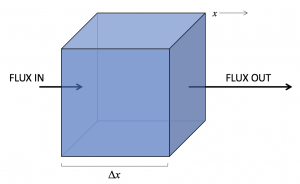64 Changing Concentration related to Flux Divergence

We will derive a relationship between the time rate-of-change of total amount of substance inside the control volume (Concentration times Volume) and the difference in transport across the sidewalls:
![]()
Since the volume does not change:
![]()
![]()
First, let us just consider the contribution to the total rate of concentration change due to the x-component of flux shown in the figure above. Remember that transport is flux times area. For the x-component of flux (![]() ), the relevant face has area
), the relevant face has area ![]() :
:
![]()
Now divide by the volume (the ![]() cancels out of the numerator and denominator on the right side):
cancels out of the numerator and denominator on the right side):
![]()
Now change the sign on the right so that the numerator represents a ![]() in the direction of increasing x. Then allow the control volume to become infinitesimally small so that the ratio of discrete changes in the x-direction can be represented by the continuous first partial derivative.
in the direction of increasing x. Then allow the control volume to become infinitesimally small so that the ratio of discrete changes in the x-direction can be represented by the continuous first partial derivative.
![]()
There are similar contributions due to variations of fluxes in the other two coordinate directions:
![]()
![]()
Add these all together for how the total time rate of change of concentration relates to the flux divergence:
![]()
Media Attributions
- 1D Flux Divergence © Susan Hautala is licensed under a CC BY-NC-SA (Attribution NonCommercial ShareAlike) license

